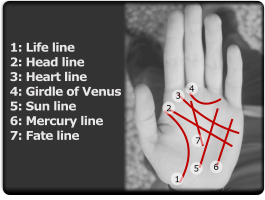Palmistry
Palmistry in History
Palmistry is one of the many arts that humans use to try and understand their past and present and foretell their future. It is such an ancient art that history doesn't record exactly when humankind first practiced it as a form of divination. In the oldest traditions, the art of reading the hand was called cheiromancy. The term "palmistry" came into popular use in the seventeenth centrury1.
History does record that palmistry, also known as hand reading, is found in Greek, Roman, Arabic, Indian, Chinese, and Japanese cultures. One legend tells that Aristotle (384-322 B.C.E.) presented a golden treatise on palmistry to Alexander the Great (356-323 B.C.E.) who used it to read the palms of his officers. Other historical figures that practiced palmistry are Napoleon Bonaparte, Hippocrates, Homer, and Galen2. Although modern science and skeptics doubt its validity, palmistry is still highly regarded and practiced in many Oriental cultures1.
Reading the Hand
Read horizontal lines from the thumb side across, vertical lines from the wrist up3.
Also called the "realistic" hand and usually the one you use for writing, the dominant hand is read first to identify the subject's past life and present condition4, 5. The other hand, the "receptive" hand, is read second to define the talents of the individual and divine the individual's future. Although some palmists read the whole hand, including the shape of the hand, wrist lines, fingers, and even finger nails3, the lines of the hand and the mounts are most often read.
The Mounts
The mounts of the hand are those fleshy parts directly below the fingers, the thumb, and the fleshy part of the hand below the little finger. The planetary names of the mounts remind us of palmistry's close association to another form of divination, astrology7.
- Jupiter – located at the base of the forefinger, associated with ambition and pride.
- Saturn – at the base of the second finger, associated with reliability and responsibility.
- Apollo – at the base of the third (ring) finger, associated with enthusiasm, creativity, and people skills.
- Mercury – at the base of the little finger, associated with verbal skills, quick wit, and mental alertness.
- Venus – the fleshy part of the hand at the base of the thumb, association energy, sympathy, and generosity.
- Luna – The "Mount of the Moon" is the thicker part of the hand directly below the mount of Mercury, associated with intuition, sensitivity, emotion, and travel
The Lines
Palmists believe that the lines of the hand are intricately linked to the flow of human consciousness. The major lines of the hand are the life line, head line, Girdle of Venus, sun line, mercury line, and fate line. Other lines (chains, crosses, breaks, and forks) along with unlined areas (islands) of the hand are read to show disruptions and changes in the subject's life.

- Life line – The belief that the life line is an indicator of the length of a person's life is mistaken. However, the life line is an indicator of the strength, vitality, and enjoyment a person will experience during his or her life.
- Head line – Just as you might expect, the head line indicates your quality of mind, eagerness to learn, and capacity for rational, logical decision making.
- Heart line – More than just your love life, your heart line reveals the love and affection you feel for all of the people in your life8.
- Girdle of Venus – A sister line to the heart line, the Girdle of Venus is also concerned with emotions and affection. Sometimes broken, sometimes solid, the Girdle of Venus tells you how well you keep your emotions under control7.
- Sun line – Although not present on every hand, the Sun line or "Apollo line" can give you an indication of your inspirational abilities and creativity.
- Mercury line – Also called the "health line", in addition to health, palmists read the mercury line to divine a subject's intuition and business acumen.
- Fate line – Running up the palm towards the second finger, Saturn, the fate line represents purpose and direction.
The human hand is our link to the world outside our bodies. It touches, grasps, holds, and carries. It is little wonder that through the ages, people all over the world have sought to understand the its lines in the possibility that these hardworking extremities are additionally links to the inner mysteries of life.
2. “Palmistry .” Gale Encyclopedia of the Unusual and Unexplained. 2003. 26 Sep 2008 <http://www.highbeam.com/doc/1G2-3406300167.html>.
3. Michael Booth. “The map: On the other hand ... Your hand reveals whether you are a boffin or in line for alien abduction. Okay, perhaps not. Michael Booth gets to grips with palmistry..” The Independent 2 Jan 1999. 26 Sep 2008 <http://www.highbeam.com/doc/1P2-4972252.html>.
4. “PALMISTRY; The science of skin and intuition .” Boise Weekly 11 Feb 2003. 26 Sep 2008 <http://www.highbeam.com/doc/1P3-507724671.html>.
5. Nathanial Altman. The Palmistry Workbook. Sterling Pub Co. September 1984. 26 September 2008
6. “palmistry .” The Free Dictionary. 2008. 26 Sep 2008 <http://www.thefreedictionary.com/palmistry>.
7. "The Girdle of Venus." Palmistry International. 2001. 26 Sep 2008. <http://www.palmistryinternational.com/girdleofvenus.htm>
8. Dennis Fairchild, Julie Paschkis. “The Major Lines.” Palm Reading: A little Guide to Life's Secrets. Running Press, 1995. 27 Sep 2008 <http://books.google.com/books?hl=en&id=26y0RWm1by8C&dq=Palm+Reading&printsec=frontcover&source=web&ots=sj-HUuT8wA&sig=sAwyaDO4lUihpcs4LkICg1-B_10&sa=X&oi=book_result&resnum=14&ct=result#PPT103,M1>.
